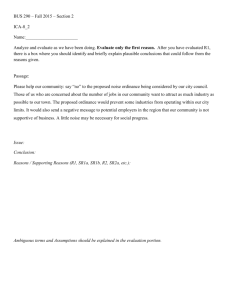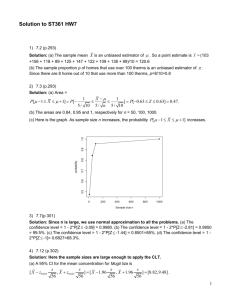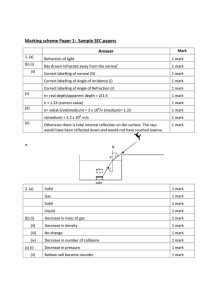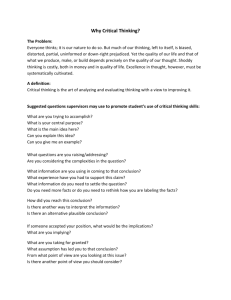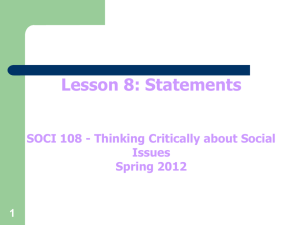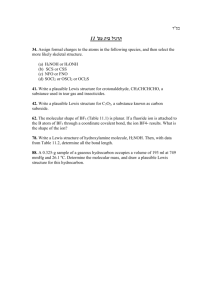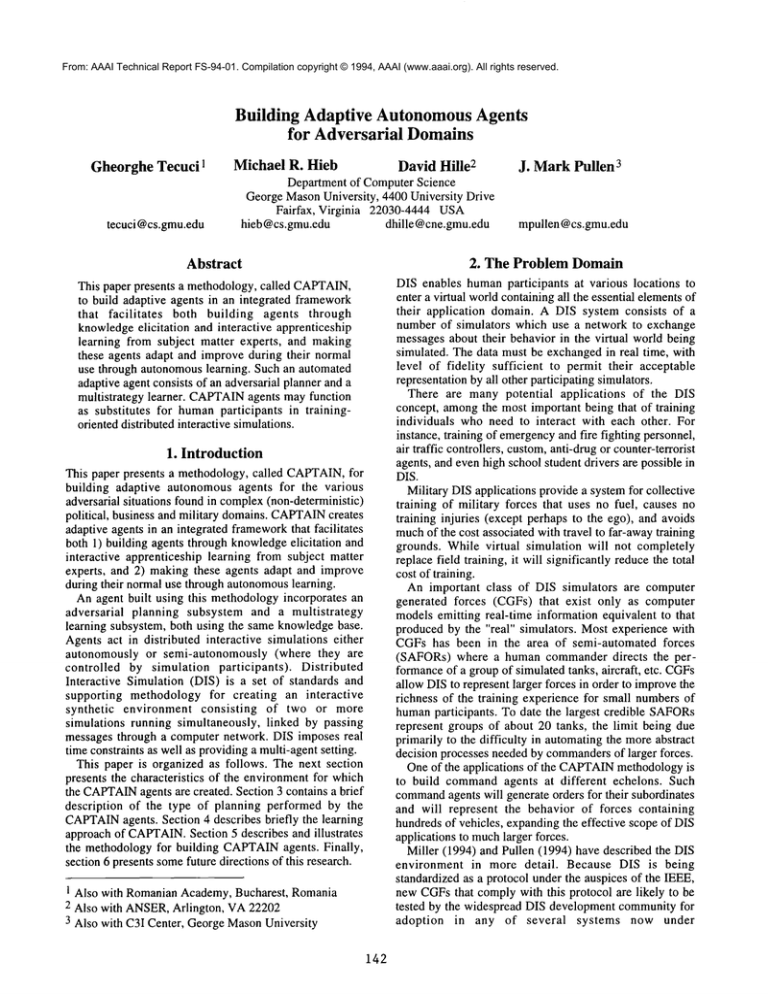
From: AAAI Technical Report FS-94-01. Compilation copyright © 1994, AAAI (www.aaai.org). All rights reserved.
Building Adaptive AutonomousAgents
for Adversarial Domains
Gheorghe Tecuci I
2Michael
tecuci @cs.gmu.edu
R. Hieb
David Hille
Department of Computer Science
George MasonUniversity, 4400 University Drive
Fairfax, Virginia 22030-4444 USA
hieb@cs.gmu.edu
dhille@cne.gmu.edu
Abstract
This paper presents a methodology, called CAPTAIN,
to build adaptive agents in an integrated framework
that facilitates
both building agents through
knowledgeelicitation and interactive apprenticeship
learning from subject matter experts, and making
these agents adapt and improve during their normal
use through autonomouslearning. Such an automated
adaptive agent consists of an adversarial planner and a
muitistrategy learner. CAPTAIN
agents mayfunction
as substitutes for humanparticipants in trainingoriented distributed interactive simulations.
1. Introduction
This paper presents a methodology, called CAPTAIN,
for
building adaptive autonomous agents for the various
adversarial situations found in complex(non-deterministic)
political, business and military domains. CAPTAIN
creates
adaptive agents in an integrated frameworkthat facilitates
both 1) building agents through knowledgeelicitation and
interactive apprenticeship learning from subject matter
experts, and 2) making these agents adapt and improve
during their normal use through autonomouslearning.
An agent built using this methodologyincorporates an
adversarial planning subsystem and a multistrategy
learning subsystem, both using the same knowledgebase.
Agents act in distributed interactive simulations either
autonomously or semi-autonomously (where they are
controlled by simulation participants).
Distributed
Interactive Simulation (DIS) is a set of standards and
supporting methodology for creating an interactive
synthetic environment consisting
of two or more
simulations running simultaneously, linked by passing
messages through a computer network. DIS imposes real
time constraints as well as providinga multi-agentsetting.
This paper is organized as follows. The next section
presents the characteristics of the environmentfor which
the CAPTAIN
agents are created. Section 3 contains a brief
description of the type of planning performed by the
CAPTAIN
agents. Section 4 describes briefly the learning
approach of CAPTAIN.
Section 5 describes and illustrates
the methodology for building CAPTAIN
agents. Finally,
section 6 presents somefuture directions of this research.
1 Also with RomanianAcademy, Bucharest, Romania
2 Also with ANSER,Arlington, VA22202
3 Also with C3I Center, George MasonUniversity
142
J. Mark Pullen3
mpullen@cs.gmu.edu
2. The Problem Domain
DIS enables humanparticipants at various locations to
enter a virtual worldcontaining all the essential elementsof
their application domain. A DIS system consists of a
number of simulators which use a network to exchange
messagesabout their behavior in the virtual world being
simulated. The data must be exchangedin real time, with
level of fidelity sufficient to permit their acceptable
representation by all other participating simulators.
There are many potential applications of the DIS
concept, amongthe most important being that of training
individuals who need to interact with each other. For
instance, training of emergencyand fire fighting personnel,
air traffic controllers, custom,anti-drug or counter-terrorist
agents, and even high school student drivers are possible in
DIS.
Military DISapplications provide a systemfor collective
training of military forces that uses no fuel, causes no
training injuries (except perhaps to the ego), and avoids
muchof the cost associated with travel to far-away training
grounds. While virtual simulation will not completely
replace field training, it will significantly reduce the total
cost of training.
An important class of DIS simulators are computer
generated forces (CGFs) that exist only as computer
modelsemitting real-time information equivalent to that
produced by the "real" simulators. Most experience with
CGFshas been in the area of semi-automated forces
(SAFORs) where a human commander directs the performanceof a group of simulated tanks, aircraft, etc. CGFs
allow DISto represent larger forces in order to improvethe
richness of the training experience for small numbersof
humanparticipants. To date the largest credible SAFORs
represent groups of about 20 tanks, the limit being due
primarily to the difficulty in automatingthe moreabstract
decision processes needed by commanders
of larger forces.
One of the applications of the CAPTAIN
methodologyis
to build commandagents at different echelons. Such
command
agents will generate orders for their subordinates
and will represent the behavior of forces containing
hundreds of vehicles, expandingthe effective scope of DIS
applications to muchlarger forces.
Miller (1994) and Pullen (1994) have described the
environment in more detail.
Because DIS is being
standardized as a protocol under the auspices of the IEEE,
new CGFsthat complywith this protocol are likely to be
tested by the widespread DIS development communityfor
adoption in any of several systems now under
development. This will provide a practical validation of
howwell the decision processes of humansare captured in
CGFscreated under CAPTAIN.
3. Planning in CAPTAIN
The main task for commandagents built with CAPTAIN
is
to generate orders for subordinate agents. Command
agents
must plan to determinehowto accomplishtheir goals in the
current situation, recognizewhentheir current plans are no
longer viable, and replan when appropriate. They must
react quickly and effectively to changes in enemytactics,
their environment, and their mission. A command
agent in
the DIS environment must produce reasonable behavior in
a wide range of situations. The dynamicnature of the DIS
environment drives the need for developing a knowledge
intensive agent architecture that includes a simple but
powerfulplanning systemable to plan at different levels of
abstraction and deal effectively with various kinds of
constraints.
The CAPTAINplanning system takes as input the
commandagent’s goals, the current situation, and the
agent’s knowledge base (KB), and generates as output
decisions such as orders for subordinate agents. The KB
contains various kinds of knowledgeabout a domainsuch
as goal-plan hierarchies, facts, concept hierarchies,
inference rules, and determinations.
The planning process is based on matching and adapting
stored skeletal plans to the current situation. A collection of
such skeletal plans for accomplishinga certain mission is
represented as a set of goal-plan hierarchies. To establish a
plan, the agent first identifies a skeletal goal-planhierarchy
applicable to its current mission (e.g., hasty defense of
position) and the current situation, then instantiates the
plan. This instantiation process establishes orders to
subordinates. This approach reduces the computational
expenseof planning and supports rapid replanning.
If there is time available, the agent uses gametree search
techniques in generating a plan (Young & Lehner 1986;
Applegate, Elsaesser & Sanborn 1990; Hieb, Hille &
Tecuci 1993), by evaluating its actions and actions of other
agents (friendly and enemy)in its environment.
To performthe search, the planner first divides the time
period of its operationsinto a series of time intervals. Then,
for each time interval, the planner identifies each plausible
combination of actions by agents to accomplish their
respective goals. Fromthis, the planner generates a tree of
possible future states resulting from the actions of agents,
together with the probabilities of reaching the different
states. The planner searches this tree to a specified depth,
after whichit evaluates the resulting states by using a static
evaluation function. Based on this search, the planner
establishes the set of agent actions considered best,
together with the time intervals in whichthe actions maybe
taken. By considering only actions associated with
accomplishingthe goals in the goal-plan hierarchies, the
planning systemheuristically limits its search only to the
most relevant portions of the search space. The depth of the
search and aggressiveness of pruning depends on the
amount of time available. Higher level commandagents
typically have longer decision cycles and are therefore able
to employsuch techniques in the planning process.
143
4. Learning in CAPTAIN
The main learning task in CAPTAINis to build and
improve the incomplete and partially incorrect knowledge
base of the agent. The learner uses a multistrategy taskadaptive learning method which dynamically integrates
different learning strategies (such as explanation-based
learning, analogical learning, abductive learning, empirical
inductive learning, etc.), dependinguponthe characteristics
of the learning task to be performed(Tecuci 1994).
As described in the previous section, the generation of
orders by the automated command
agent is guided by goalplan hierarchies which represent military doctrine and the
experience of subject matter experts. The goal-plan
hierarchies are developedby learning and aggregating rules
for decomposingand specializing goals. The condition of
each rule refers to the context concerning mission, enemy,
terrain, troops, and time. A partially learned condition is
expressed in terms of a plausible version space (Tecuci
1992), as shownin Figure 1. Examplesof such plausible
version spaces are given in section 5.
IF
plausible upper boundof the condition
plausible lower boundof the condition
THEN
conclusion
Figure 1: Arule with a partially learned condition.
As shownin Figure 1, the plausible version space of a
rule condition consists of two expressions, called the
plausible lower bound of the condition and the plausible
upper boundof the condition. The plausible lower boundis
an expressionthat is most likely to be less general than the
exact condition of the rule, and the plausible upper bound
is an expression that is most likely to be moregeneral than
the exact condition. During learning, the two bounds
convergetowardthe rule’s condition.
Testing the condition of a rule (or the plausible version
space of the condition) mayinvolve matching the current
situation or performing plausible reasoning on the
knowledgebase and the current situation.
Plausible inferences are madeby using the rules from the
KB not only deductively,
but also abductively or
analogically, or by using weaker correlations between
knowledge pieces as, for instance, determinations,
dependencies or related facts (DeJong & Oblinger 1993;
Hieb & Michalski, 1993; Tecuci & Duff, 1994). In order to
test a rule condition Pn(a,b) the systemis not restricted
makingonly one plausible inference. In general, it could
build a plausible justification tree like the one in Figure 2
(Tecuci 1994). A plausible justification tree is like a proof
tree, except that the inferences which composeit may be
the result of different types of reasoning (not only
deductive, but also analogical, abductive, predictive, etc.).
The basis for apprenticeship and autonomouslearning
comesfrom recognizing whenthe rule is not correct in the
current situation. For instance, if the rule should matchthe
current situation, then the plausible lower boundof the
P(a,b)
} Rule condition
.,¢’,,.
Po(a,b) P,~(b)
Pu(a,c)
Pw(b)t
P(d)
Pl(a,0P2(g,a)P4(h)...
Pi(b,e)
. ael
Knowledge
Elicitation
Different
types of
inference
(deductive,
analogical,
abductive,
etc.)
} Factsdes.crih!ng
current situation
t
Knowledge
Engineer
~1 Apprenticeship I~
l earng)
Figure 2: Aplausible justification tree
for testing the rule conditionPn(a,b).
¼
Interactive
Agent
conditionis generalizedto cover the current case. Or, if the
rule should not match the current situation, then the
plausible upper boundof the condition is specialized to
uncover the current case. If testing the rule’s condition
involves building a plausible justification tree like the one
in Figure 2, then learning consists of hypothesizingthat the
plausible inferences madeto build the tree are correct, if
the rule’s condition(i.e., Pn(a,b)) shouldbe satisfied.
Distributed
Simulation
Interactiv~
. Phas~e
~
5. The CAPTAIN
Methodology
3
~/
Autonomous
Agent
The process of building automatedadaptive agents consists
of three stages, KnowledgeElicitation, Apprenticeship
Learning, and AutonomousLearning, as shownin Figure 3.
Thesestages are presented in the following subsections.
Figure 3: The main stages of building a CAPTAIN
agent.
Knowledge Eiicitation
KBis called Acceptable Deductive Closure (AC), and
representedin Figure 4.
Figure 4 shows also the Plausible Closure (PC) of the
initial KB,whichrepresents the set of all plans that can be
derived from the initial KBby using plausible inferences.
As can be seen from Figure 4, DCis an approximate lower
boundfor ACin the sense that most of DCis included in
AC. Also, PC is an approximate upper boundfor ACin the
sense that most of ACis included in PC. The set ACis not
knownto the system (otherwise its knowledge would be
almost correct and complete). However, any set X that
includes most of DCand most of which is included in PCis
a hypothesis for being the set AC. Wecan therefore
consider PC and DCas defining a plausible version space
(Tecuci 1992) that includes the sets that are candidates for
being the set AC. With this interpretation, the agent’s
apprenticeship learning problem reduces to one of
searching the set ACin the plausible version space defined
by DCand PC. Because the goal is to refine the KBof the
agent so that its deductive closure becomesAC,DCis used
as the current hypothesis for AC,and PC is used as a guide
for extending DC, to include more of PCc~ AC, as well as
for correcting DC, to removemost of DC-AC
from it.
There are three Interactive Learning Modesinvolving an
SMEthat are available during this phase as shown in
Figure 5: Teaching, Cooperatingand Critiquing.
In the first phase, Knowledge
Elicitation, the subject matter
expert works with a knowledgeengineer to define an initial
KB.They generate a list of typical concepts, organize the
concepts, and encodea set of rules and various correlations
between knowledgepieces expressed as determinations or
dependencies, which will permit the system to perform
various types of plausible reasoning. Such knowledge
elicitation techniques are described in (Gammack
1987;
Tecuci &Hieb 1994). The resulting initial KBwill contain
whatever knowledge could be easily expressed by the
expert. The KBis expected to be incomplete and partially
incorrect at this point. Figure 4 shows the Deductive
Closure (DC)of this initial KB,whichrepresents the set
plans that can be deductively derived with the knowledge
from the KB(Tecuci & Duff 1994). Someof the derived
plans maybe wrong(because the KBis partially incorrect),
while other plans maynot be derivable at all (because the
KBis incomplete).
Apprenticeship
Learning
In the second phase, Apprenticeship Learning, the agent
will learn interactively from the subject matter expert by
employingapprenticeship multistrategy learning (Tecuci
Kodratoff 1990; Tecuci 1992; Hille, Hieb &Tecuci 1994).
Duringthis phase, the agent’s KBis extendedand corrected
until it becomescomplete and correct enough to meet the
required specifications. Thedeductiveclosure of this final
144
by the SME,the agent commandinga security element
under the battalion commandagent encounters a small
enemyforce consisting of two reconnaissance vehicles.
The agent has insufficient knowledgeto decide what orders
to give. The SMEinstructs the company commandagent
that the security element should attack the enemy. The
agent will require an explanation of whythis is the correct
order and the SMEwill respond: "The order is appropriate
because the fire power of the security element is much
greater than the fire power of the two reconnaissance
vehicles." The rule learned from this example (and the
explanation provided by the SME)is given as R1.
RI: IF
plausible upper bound
the security element has greater fire power
than an enemyforce
Figure 4: The relationship between DC, PC, and AC.
1) In the Teaching Mode,the SMEwill showthe agent
examplesof typical situations and correct orders to give to
subordinate units to achieve the goals of a certain mission.
Fromeach such scenario, the agent will learn a rule that
will allow it to respond adequatelyto situations similar to
the one indicated by the SME.The agent will attempt to
understand the situation-action example given, by asking
the SMEquestions and asking for explanations when
necessary. It mayalso elicit newconcepts or relations from
the SME,when it does not have the required knowledge
available. This mode will require the most time and
involvement of the SMEbecause the agent does not
initially have a good "understanding"of the concepts that
the SMEwishes to teach.
Consider, for instance, a situation in which the SME
wishes to teach the commandagent how to maintain
security of a tank and mechanizedinfantry battalion task
force during a tactical road march. In an exampleprovided
plausible lower bound
the security element has muchgreater fire power
than an enemyforce consisting of two
reconnaissance vehicles
THEN
order the security element to attack the enemyforce
As one can notice, instead of an exact applicability
condition, the learned rule has two conditions, the plausible
upper bound and the plausible lower bound. The plausible
lower bound is the explanation provided by the SME.This
boundis specific enoughto ensure the enemyelements will
be weakenoughfor the security element to handle, but is
too specific to cover all applicable situations. It is
consistent but incomplete. The plausible upper boundis a
generalization of the explanation provided by the SME
(Tecuci 1994). This boundis general enoughto cover most
situations, but maybe too general since having greater
firepower does not necessarily ensure that the enemy
elements encountered will be weak enough to be attacked
IIIIII
II
IIIIIIIII
TEACHING
the Agent
through examples of
typical scenarios
Subject
COOPERATING
with the
Agent to generate orders
during a scenario
the Agent’s
performance by
identifying failures
CRITIQUING
AUTONOMOUS
PERFORMANCE
by the Agent (learning from
its ownexperience )
Figure 5: Different Modesof Learning in CAPTAIN
145
Multistrategy
Learning
System
successfully by the security element. It is almost complete
but inconsistent.
Notice however,that the aboverule is quite useful and it
was learned only from an example and an explanation.
Whenapplying such an incompletely learned rule, if the
lower bound condition is satisfied then the system "considers" the conclusion as true. If the upper boundcondition
is satisfied, but the lowerboundcondition is not satisfied,
then the conclusionis only consideredplausibly true.
As mentioned in section 4, the two bounds define a
plausible version space for the exact condition to be
learned by our multistrategy learner. This learning process
is an incremental one in which the two plausible bounds
will converge toward the exact applicability condition of
the rule. The bounds and the version space are called
plausible because they have been initially formedbased on
an incomplete explanation and its over-generalization.
Also, the learning process takes place in an incomplete
representation language that maycause the bounds to be
inconsistent (a lower bound that covers some negative
examples or an upper bound that does not cover some
positive examples).
2) In the Cooperating Mode, the agent will work
through a simulation scenario with the help of the SME.
The agent will issue orders for a given mission and the
SMEwill either verify that they are correct, or propose
specific changes that the agent can learn from. The aim of
the Cooperating Modeis to improve the rules that have
already been learned. This interaction is easier for the SME
than the previous mode,because the agent is generating the
orders. The system will require less explanation and will
not need to elicit as muchnewinformation.
Suppose, for instance, that the security element
encounters an enemyinfantry fighting vehicle in the path
of the battalion. The plausible lower bound of the rule
learned under the Teaching Modeis not satisfied (the
infantry fighting vehicle is not classified
as a
reconnaissance vehicle). However, its plausible upper
boundis satisfied (the infantry vehicle has less firepower
than the security element). Thus the rule is likely to be
applicable and the agent asks the expert to verify its
conclusion. The SMEagrees and the attack is performed
successfully, with the vehicle destroyed. The learning
systemwill take this instance of the rule as a newpositive
example, and will use it to generalize the plausible lower
bound. This generalization uses a type hierarchy of
vehicles, where both infantry fighting vehicles and
reconnaissance vehicles are classified as light armored
vehicles. The improvedrule is given as R2.
Rules are continuously improved in this manner, based
on positive and negative examples, generated during
apprenticeship learning by the SME.The learning process
decreases the distance between the two plausible bounds.
This process should, in principle, continue until the lower
bound becomes identical with the upper one - at this
momentan exact rule is learned. However, because the
agent’s knowledgeis incompleteand partially incorrect, the
agent maybe unable to learn a rule with an exact condition
and will needto rely on an incompletelylearned rule.
3) In the Critiquing Mode, the agent will perform
unassisted in a simulation scenario. This simulation is
recorded by a Loggerso that it can be played back later by
146
R2: IF
plausible upper bound
the security element has greater fire power
than an enemyforce
plausible lower bound
the security element has muchgreater fire power
than an enemyforce consisting of two or fewer
light armoredvehicles
THEN
order the security element to attack the enemyforce
the SME,whowill select particular orders that were not
generated properly, and suggest better orders. This mode
could be thought of as "debugging"the learned knowledge.
The aim is to verify that the learned knowledgeis correct,
and to improveit whennecessary.
Let us suppose that the Logger shows a situation in
which the security element consisting of a scout platoon
and a tank platoon encounters a dug-in enemy antitank
platoon during a tactical road march. The security element
assaults the antitank platoon and the attack fails with heavy
losses, since they came under fire by a group of heavy
antitank weapons and lacked the fire power to quickly
defeat the dug-in forces. The SMEtells the agent that
ordering the security element to attack the dug-in antitank
platoon was a mistake because "the security element must
have greater protection than the enemyforce".
The SME’sexplanation suggests adding to both bounds
of the rule the additional conditionthat the security element
must have greater protection than the enemy force.
Therefore, the newrule is shownas R3.
R3: IF
plausible upper bound
the security element has greater fire power
than an enemyforce, and security element has
greater protection than the enemyforce
plausible lower bound
the security element has muchgreater fire power
than an enemyforce consisting of two or fewer
light armoredvehicles, and security element has
greater protection than the enemyforce
THEN
order the security element to attack the enemyforce
In addition, an opportunity exists to learn a newrule for
issuing orders when a security element meets an enemy
force that has greater protection.
Providing explanations of the command
agent’s failures
is not a necessary condition for learning. Let us suppose,
for instance, that the SMEonly indicates that attacking the
dug-in antitank platoon was a mistake, but does not give
any explanation. In such a case, the agent will attempt to
specialize the plausible upper boundof the rule’s condition
such that it no longer coversthis situation, and still remains
moregeneral than (or at least as general as) the plausible
lower bound.
Because the agent’s representation
language is
incomplete, it maynot alwaysbe possible to specialize the
plausible upper boundas indicated above. In such a case,
the situation-action pair is explicitly associated with the
rule, as a covered negative example. Suchcovered negative
examples and, similarly, uncovered positive examples,
point precisely to the incompleteness of the agent’s
knowledge, and are used to guide the elicitation of new
concepts and features, by using the knowledgeelicitation
methodsdescribed in (Tecuci & Hieb 1994).
These learning
techniques
have been already
demonstrated in the learning apprentice systems DISCIPLE
(Tecuci & Kodratoff 1990) and NeoDISCIPLE(Tecuci
1992, Tecuci & Hieb 1994), which use multistrategy
learning, active experimentation and consistency-driven
knowledgeelicitation, to acquire knowledgefrom a human
expert. Asignificant feature of these systemsis their ability
to acquire complex knowledge from a human expert
through a very simple and natural interaction.
Althoughthe rules are learned from concrete examples,
the explanations provided by the SMEare often composed
of abstract concepts like "fire power," "protection," etc.
Therefore, the abstract rules learned need to be
operationalized, to be readily applicable for planning. This
operationalization
is based on building plausible
justification trees. For instance, if a rule conditioncontains
the abstract concept "Pn(a,b)" then, according to the
plausible justification
tree in Figure 2, a possible
operationalizationof this conceptis
"P l(a,f) &P2(g,a) &P4(h) &...& Pi(b,e)".
A side effect of this operationalization process is the
extension of the KBwith new pieces of knowledge that
need to be hypothesizedin order to build the corresponding
plausible justification tree.
Autonomous Learning
Whenthe agent has been trained with examples of the
typical situations it should be able to cope with, it enters a
third phase, AutonomousLearning, where it is used in
simulations without the assistance of the subject matter
expert. The training received during the Apprenticeship
Learning Phase will allow the agent to solve most of the
planning problems through deductive reasoning. However,
it will also be able to solve unanticipated problemsthrough
plausible reasoning, and to learn from these experiences, in
the samewayit learned from the expert. For instance, if the
agent generated appropriate orders by using plausible
reasoning (e.g., applied a rule based on its plausible upper
boundcondition or on a partial matchof the condition), it
will reinforce the plausible inferences used (e.g., will generalize the lowerboundof the rule’s condition, to cover the
respective situation). If, on the other hand, the agent
generatedincorrect orders, it will needto specialize the rule
that was blamedfor the wrongorder. Therefore, the agents
developedusing this approachwill also have the capability
of continuously improving themselves during their normal
use. Moreover,this approach produces verified knowledgebased agents, because it is based on an expert interacting
with, checking and correcting the way the agents solve
problems.
It is important to stress that both the apprenticeship
learning and the autonomouslearning take place off-line,
and therefore they are not constrained by the necessity of
147
operating in a real-time simulation, or the limited computational resources available during the actual simulation.
The only constraint imposedduring the actual simulation is
to keepa record of the agent’s decision process.
Learningefficiency is achieved through the use of simple
plausible version spaces and a SMEguided heuristic search
of these spaces. Because of these features, the plausible
version spaces do not suffer from the limitations of the
version spaces introduced by (Mitchell 1978). These
limitations are the combinatorial explosion of the number
of alternative boundsof a version space (there is only one
upper bound and one lower boundin the case of plausible
version spaces), the need to have manytraining examples
for the learning process to converge (significantly fewer
examplesare needed in the case of our methodbecause the
explanations of the SMEidentify the relevant features of
the examples), the use of an exhaustive search of the
version space (as opposedto the heuristic search used with
plausible version spaces), and the inability to learn when
the representation language is incomplete (as opposed to
our methodwhichcan learn partially inconsistent rules).
6. Future Research
Building adaptive autonomousagents is rapidly becoming
a major research topic integrating learning and planning
(Laird & Rosenbloom1990; De Raedt et al. 1993; Gordon
& Subramanian 1993; Minton 1993; Serge 1993; Van de
Velde 1993).
Our research on the CAPTAIN
methodologyis still at an
early stage and several research issues remain to be
addressed.
¯ A main idea of the our approach is that muchof the
knowledgeneeded to improve the KBof the agent could be
derived through plausible reasoning from the knowledge
the agent already has. This is very similar in spirit to the
knowledgeacquisition methodologyof (Gil & Paris 1994)
in which muchof the knowledge needed by the system is
derived by analogy with the existing knowledge. Because
analogy, and case-based reasoning (Veloso & Carbonell
1994), for that matter, are very powerful plausible
reasoning methods, we would like to make more use of
them during planning, apprenticeship learning, and
autonomouslearning.
¯ Another issue is to determine a good measure for comparing the plausibility of different justification trees, so the
system only hypothesizes the most plausible knowledge.
¯ Anotherresearch issue is to develop a qualitative representation of the certainty of the knowledgepieces from
the KB(e.g., somefacts are characterized as true by the
expert, while others are hypothesizedas true by the system,
somerules are initially defined by the expert, while others
are learned by the system). In particular, one has to be able
to estimate the confidence in the learned rules, to update
the confidence of a rule when new examplesor exceptions
are discovered, as well as to maintain only a limited
numberof "representative" examplesof a rule that neither
overload the system, nor lose important information.
¯ There are also several research topics regarding the
planning subsystem, the most important ones being how to
better integrate hierarchical planning based on goal-plan
hierarchies with the adversarial planning based on game
tree search, as well as howto better represent the state
evaluation functions in a manner suitable for revision
during learning.
Proceedings of AAAI-90, Boston: AAAI,MITPress, 10221029.
Acknowledgments
The authors wish to thank Andy Ccranowicz, Tom
Dybala, Eric Bloedorn and Michael Tanner for helpful
commentsand suggestions. This research was conducted in
the Computer Science Department at George Mason
University.
The research of Gheorghe Tecuci was
supported in part by the NSFGrant No. IRI-9020266, in
part by the ONRgrant No. N0014P91PJP1351,in part by
the ARPAgrant No. N0014P91PJP1854,administered by
the ONR.
References
Applegate C., Elsaesser C., and Sanborn J. 1990. An
Architecture for Adversarial Planning, IEEETransactions
on Systems, Man,and Cybernetics, 20(1):186-195.
DeJong,G, and Oblinger, D. 1993. A First Theory of Plausible Inference and Its Use in Continuous Domain
Planning. In S. MintonEd., MachineLearning Methodsfor
Planning, Morgan KaufmannPublishers: San Mateo, CA,
93-125.
De Raedt, L., Bleken, E, Coget, V., Ghil, C., Swennen,B.
& Bruynooghe, M.. 1993. Learning to Survive, Proceedings of the Second International Workshop on Multistrategy Learning Harpers Ferry, WestVirginia, 92-106.
Miller, D.C. 1994. NetworkPerformance Requirements for
real-Time Distributed Simulation. In B. Plattner &J. Kiers
Eds, Proceedings of INET’94/JENC5. Internet Society
(isoc@isoc.org), 241-1 to 241-7.
Minton, S. Ed. 1993. Machine Learning Methods for
Planning, Morgan Kaufmann: San Mateo, CA.
Mitchell, T.M. 1978. Version Spaces: An Approach to
Concept Learning, Doctoral Dissertation,
Stanford
University.
Pullen, J.M. 1994. Networking for Distributed Virtual
Simulation. In B. Plattner &J. Kiers Eds, Proceedings of
INET’94/JENC5.Internet Society (isoc@isoc.org). 243-1
to 243-7.
Serge, A. 1993. "Learning how to plan" In W. Van de
Velde Ed., Towards Learning Robots. MIT Press:
Cambridge, Mass. 93-111.
Tecuci, G. & Kodratoff Y. 1990. Apprenticeship learning
in Imperfect Theory Domains. In Y. Kodratoff & R. S.
Michalski, Eds., Machine Learning: An Artificial
Intelligence Approach, Vol. III, Morgan Kaufmann:San
Mateo, CA, 514-551.
Tecuci G. 1992. "Automating KnowledgeAcquisition as
Extending, Updating and Improving a KnowledgeBase,"
IEEE Transactions on Systems, Man, and Cybernetics,
22(6): 1444- 1460.
Gammack
J.G. 1987. Different Techniques and Different
Aspects on Declarative Knowledge. In A.L. Kidd, Ed.
KnowledgeAcquisition for Expert Systems: A Practical
Handbook,Plenum Press.
Tecuci, G. 1994. A Frameworkfor Multistrategy Learning.
In R. S. Michalski &G. Tecuci, Eds., MachineLearning:
An Multistrategy Approach Vol. 4, Morgan Kaufmann:San
Mateo, CA, 107-138.
Gil Y. & Paris C. 1994. Towards Method-Independent
KnowledgeAcquisition. KnowledgeAcquisition Journal,
6(2).
Tecuci, G. & Duff, D. 1994. A Frameworkfor Knowledge
Base Refinement through Multistrategy Learning and
KnowledgeAcquisition. KnowledgeAcquisition Journal,
6(2).
Gordon, D. and Subramanian, D. 1993. A Multistrategy
Learning Scheme for Agent Knowledge Acquisition.
lnformatica, 17(4):331-346.
Hieb, M.R. & Michalski, R.S. 1993. Multitype Inference in
Multistrategy Task-adaptive Learning: DynamicInterlaced
Hierarchies. Informatica, 17(4):399-412.
Tecuci, G. & Hieb, M.R. 1994. Consistency-driven
KnowledgeElicitation: Using a MachineLearning-oriented
Knowledge Representation to Integrate Learning and
Knowledge Elicitation
in NeoDISCIPLE. Knowledge
Acquisition Journal, 6(1):23-46.
Hieb, M.R., Hille D. and Tecuci, G. 1993. Designing a
ComputerOpponent for WarGames: Integrating Planning,
Learning and Knowledge Acquisition in WARGLES.
In
Proceedings of the 1993 AAAI Fall Symposiumon Games:
Learning and Planning, AAAIPress Technical Report FS93-02, MenloPark, CA.
Van de Velde, W. 1993. Towards Learning Robots. MIT
Press: Cambridge,Mass.
Hille D., Hieb, M.R. & Tecuci, G. 1994. CAPTAIN:
Building Agents that Plan and Learn. In Proceedingsof the
Fourth Conference on Computer Generated Forces and
Behavioral Representation, May,411-422.
Laird J.E. &RosenbloomP.S. 1990. Integrating Execution
Planning and Learning in Soar for External Environments,
148
Veloso M. & Carboneil J. 1994. Case-Based Reasoning in
PRODIGY.
In R. S. Michalski & G. Tecuci, Eds., Machine
Learning: An Multistrategy Approach Vol. 4, Morgan
Kaufmann: San Mateo, CA, 523-548.
Young, P.R. & Lehner, P.E. 1986. Applications of a
Theory of Automated Adversarial Planning to Command
and Control. IEEE Transactions on Systems, Man, and
Cybernetics, 6:806-812.

